Welcome to Ceramic Review
Ceramic Review is the magazine for contemporary and historical ceramics, ceramic art and pottery.
Ceramic Review Issue 334
July/August 2025
Ceramic Review is the magazine for contemporary and historical ceramics, ceramic art and pottery.
July/August 2025
Sophie Woodrow’s porcelain figures make connections between humans and the natural world. She shares her thoughts and influences with Annie Le Santo
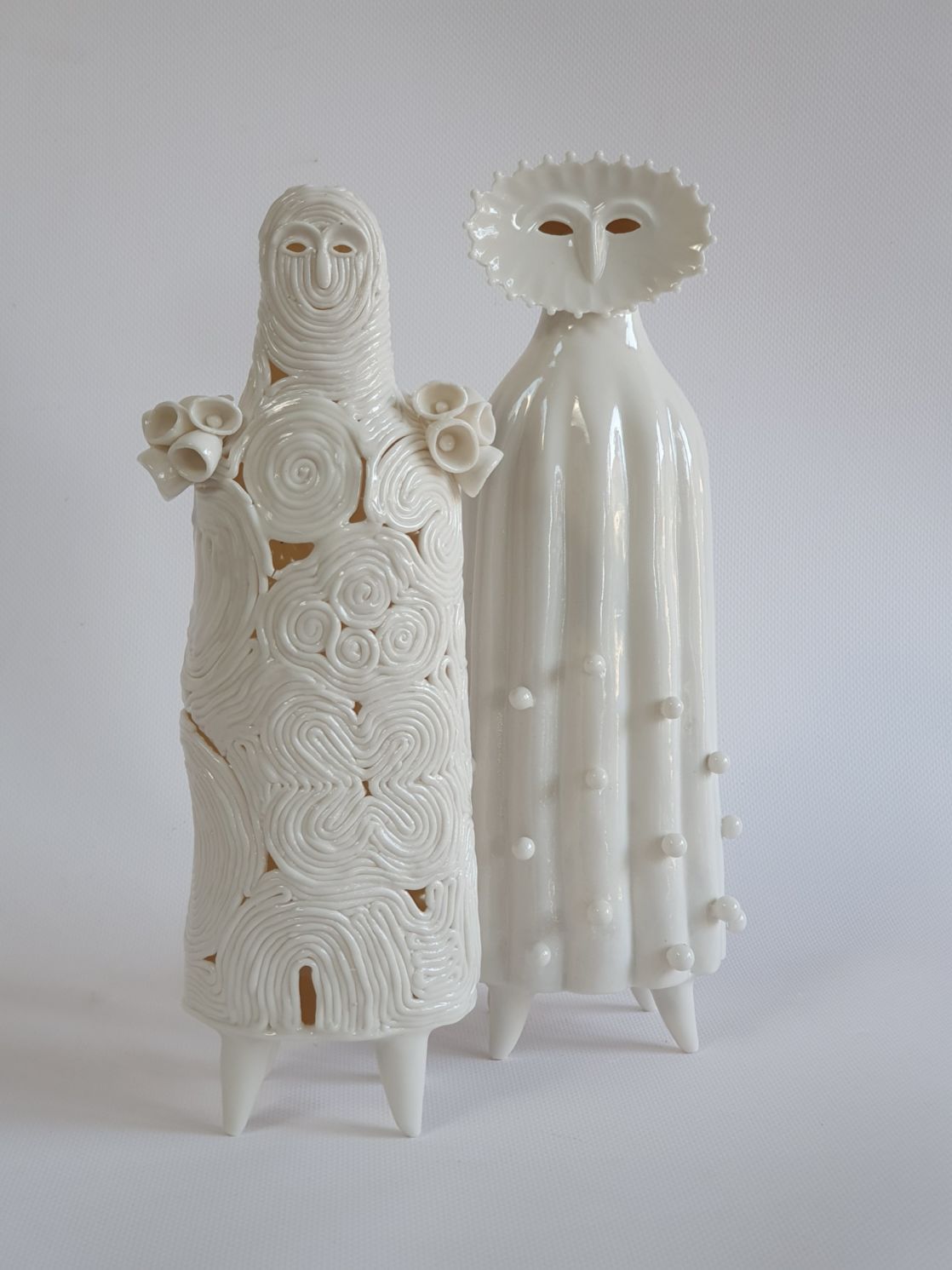
Courtesy of the artist
Encountering Sophie Woodrow’s porcelain creatures for the first time, you can imagine how our human ancestors may have felt when they discovered animals living in the wild: curious, perplexed and maybe a little cautious. Standing around 15 to 50cm tall, most of Woodrow’s figures are on the smaller side, however their presence is much greater than their physical size. With eerie eyes as windows into the hollow interior of their vessels, they invite you in, silently welcoming your questions and interpretations.
Woodrow was born in Bristol where she still lives and works today. Her mother was an abstract painter who sent her daughter to an alternative school that placed an emphasis on traditional arts and craft. Pottery was a weekly lesson up until the age of 14, and so it was there that she first engaged with ceramics. ‘Each project began with a ball of clay, which we would pinch or shape into an animal or a pot,’ she recalls. ‘It is a process I still follow today.’
In her later teenage years Woodrow attended a standard mainstream school, the contrast of which was somewhat of a shock. ‘At one point, I applied to study English Literature at university, but deep down I knew this was too “in the head” for me,’ she recalls. ‘I needed something grounding. Ceramics is a practical process that I can get lost and engaged in. There is a lovely feeling that there is always something I can be getting on with.’
With this in mind, she decided to pursue a BA Ceramics course at Falmouth University. Sadly, it was the last year the course was running before being discontinued and Woodrow didn’t quite feel like she found her feet there.
‘I decided to stay in Cornwall afterwards and got myself a studio in Penryn,’ she explains. ‘It was a tiny room with no windows, but it was amazing how much focus it gave me. Before this I found the idea of “who” I was making for very overwhelming. As soon as I was working on my own, it really didn’t matter because I didn’t think anyone was going to see what I made.’
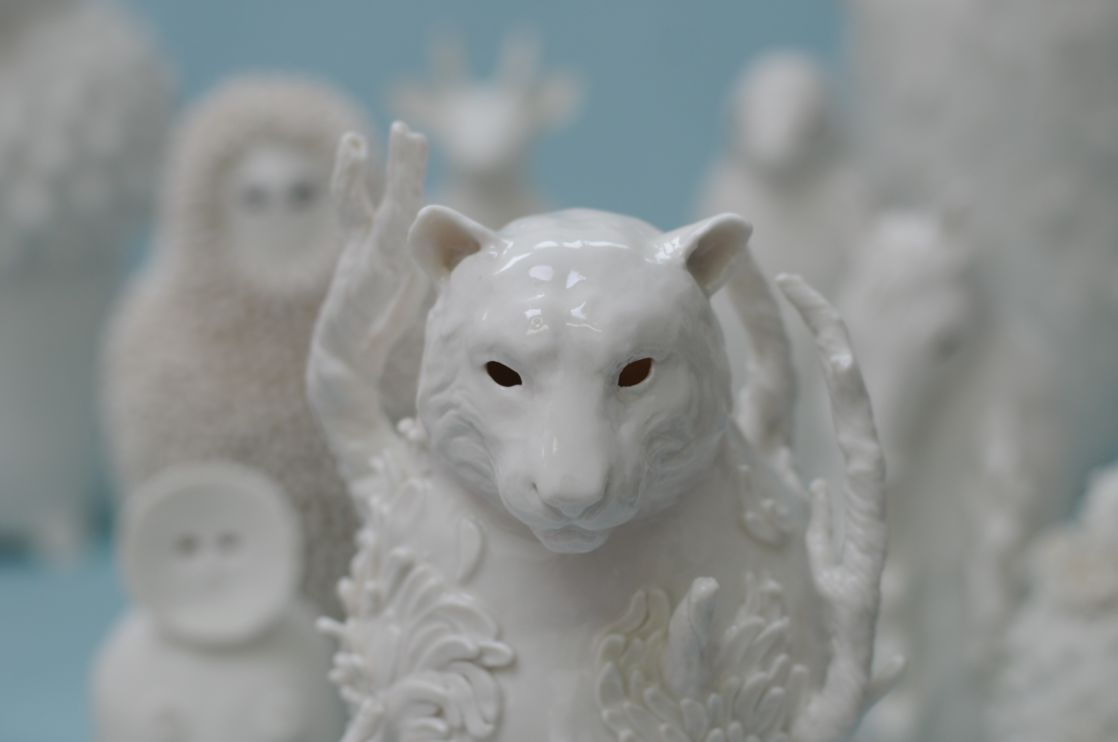
Courtesy of the artist
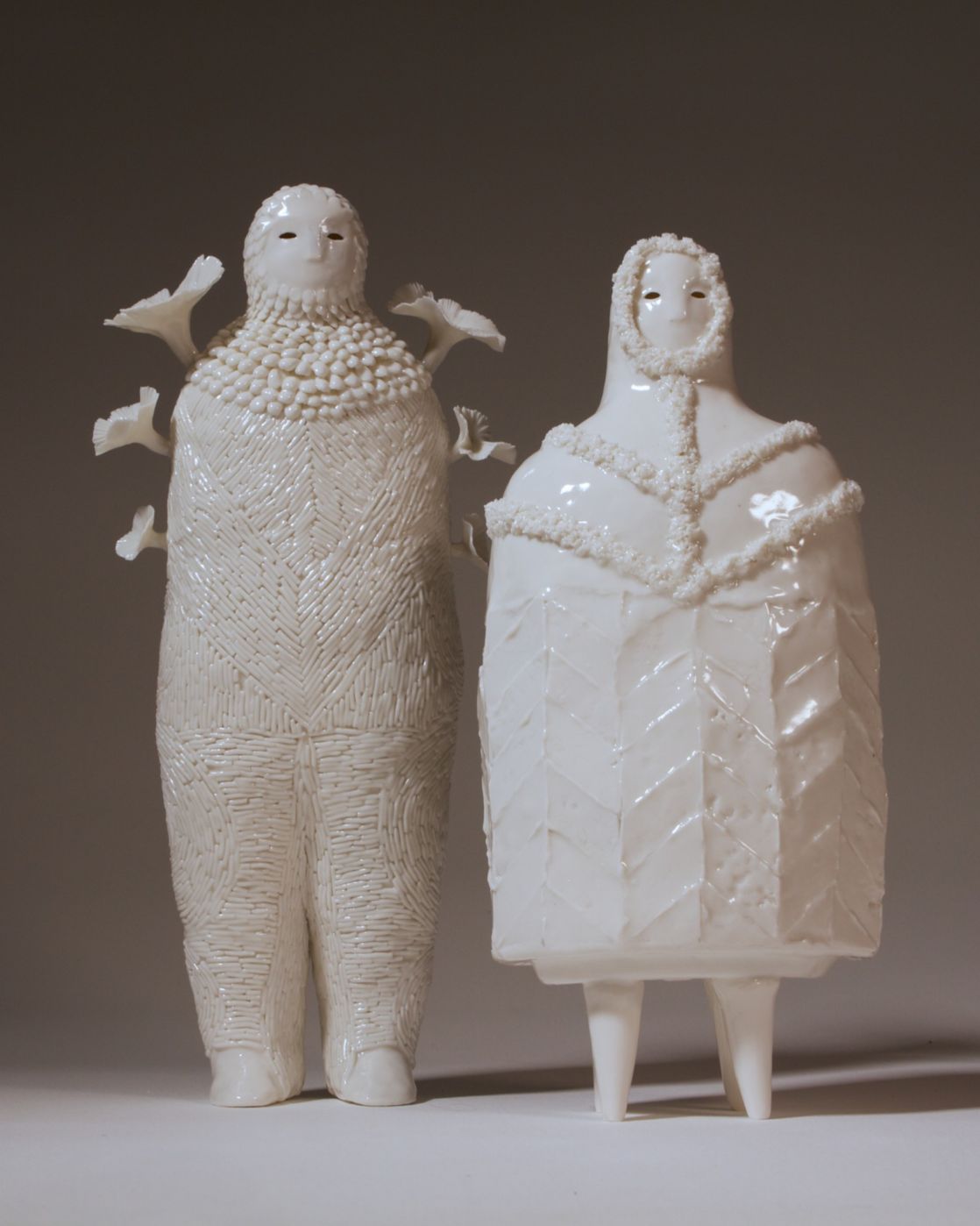
Courtesy of the artist
INTUITIVE IMAGINATION
It was a day in that small, windowless space where a key moment occurred, defining Woodrow’s practice from then onwards: a small rabbit figurine ‘popped up’. Porcelain naturally dictates that an object will be hollow, and Woodrow instantaneously made a link between the rabbit-shaped vessel and the ‘human being’ or in this case, the ‘animal being’. ‘The language of the body is wrapped up in the language of pottery. We speak about pots having necks and bellies,’ she explains. ‘Once I carved the holes of the eyes, the outside surface of the vessel connected with the inside. I started to think of my figures as inside-out portraits, connecting peoples’ inner and outer selves.’
Woodrow devoted herself to this idea and did not stop. She created sculptural figures of all shapes and forms, coiling them from the bottom to the top. Bears, owls, deer, bulls, and more recently, human-like figures, were born. Most of them are adorned with textural enhancements, whether it is a lacey ruff around their neck, a ribbon around their body, leaves, fungi or birds on their shoulders, or an abstract pattern reminiscent of organic forms.
She describes a fascination with the points where the natural world meets the human world when asked where the influence for the delicate surface details come from. Ultimately though, Woodrow cites her own imagination as her main source of inspiration. ‘There is a beautiful boundary between nature and culture, but if I am being honest, what comes first with each piece is simply the idea of being an individual,’ she says. ‘I think of the attachments on the shoulders as parts of a personal history. Throughout life we accrue people, relationships and things that we are thought to bear on our shoulders.’
The more Woodrow discloses her intuitive thought-process, the clearer it becomes that she is in possession of an enviable imagination. She is led by her subconscious and relies on these chance moments of inspiration for her complex ideas. Their conception is one that is natural, raw and unrefined. ‘I often describe myself as a “lazy researcher” because ideas will appear in my head and I will commit to them without the need to develop them any further,’ she explains. ‘Coming up with an idea feels like a type of magic. It is as though a microwave will suddenly ping and I’ll have been unaware that something has been cooking up in there.’
Woodrow’s pieces have been well-received by the public at fairs and exhibitions ever since they left her humble Penryn studio. She finds people comment frequently that they are ‘like creatures from other worlds’ and make connections to existing media, such as the Japanese animation made by Studio Ghibli. It is understandable how her porcelain animals ignite nostalgic recollections of childhood characters, fairy tales and fiction, but Woodrow insists her creatures are distant from these fantasies. They exist in our reality; she crafted them here with her own hands after all. ‘People often assume my works are story characters and that’s fine,’ she says. ‘But for me they are not visitors from another world, they are from our world and offer a different way of seeing it.’
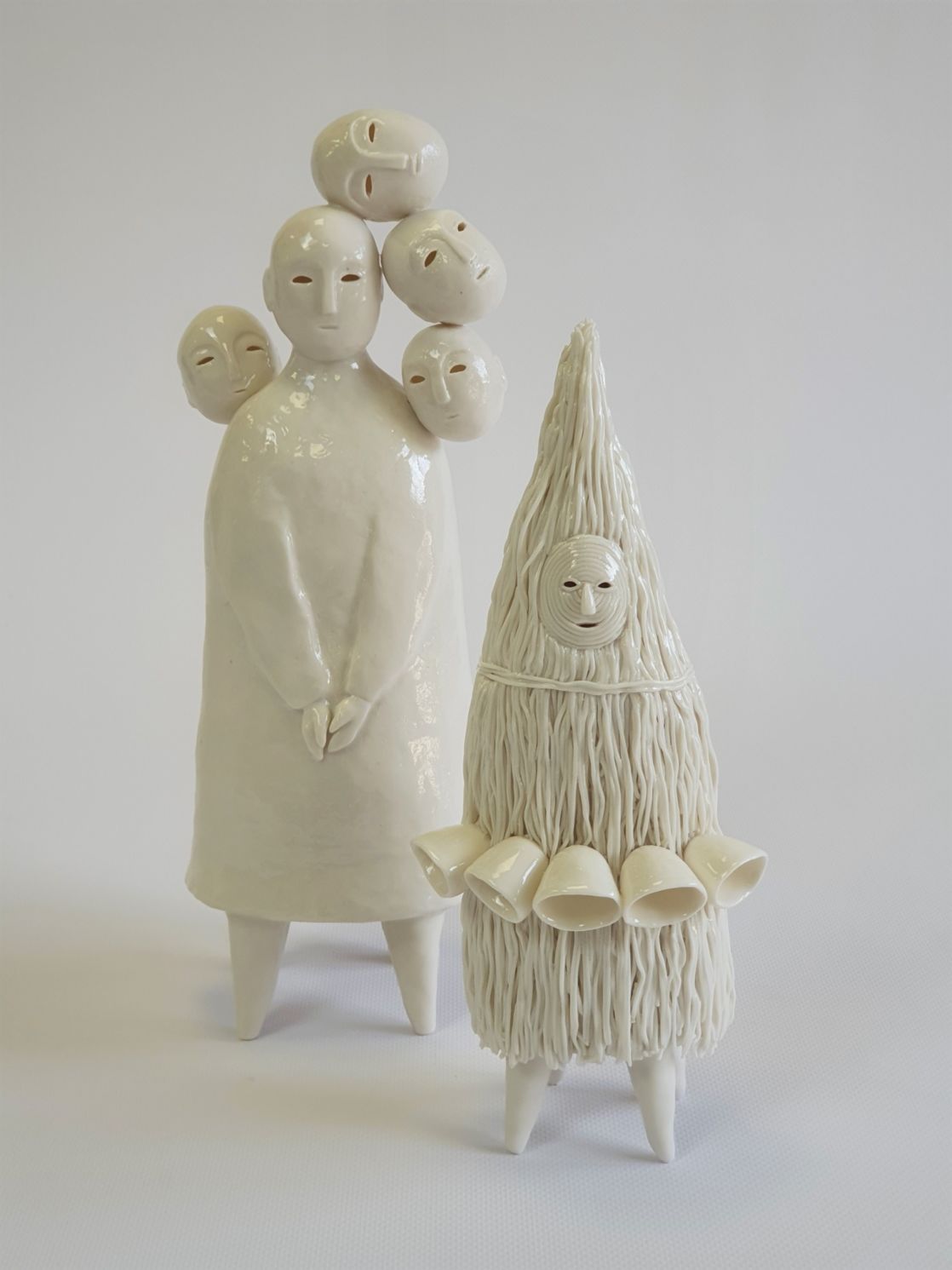
Courtesy of the artist
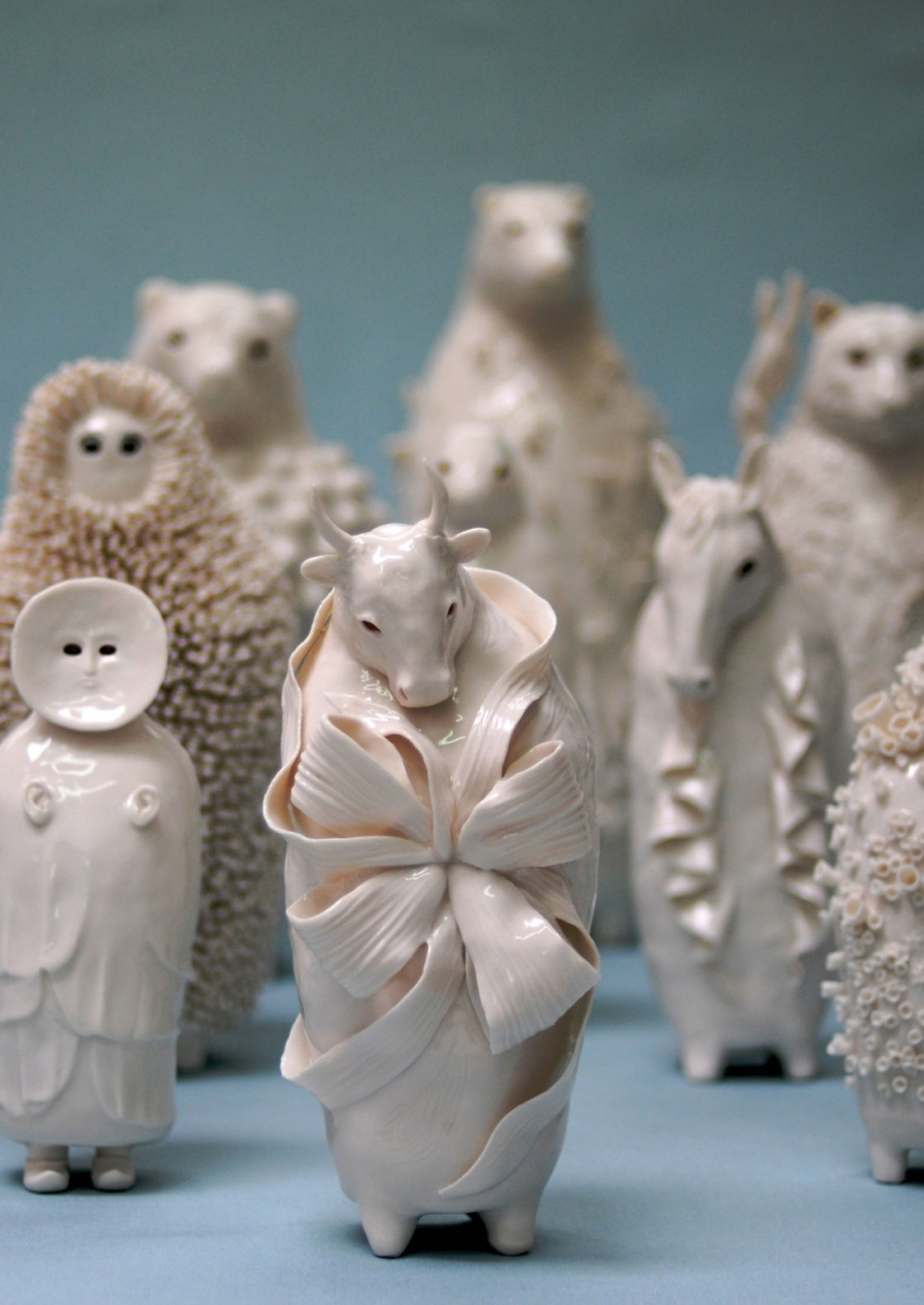
Courtesy of the artist
NEW EXPLORATIONS
Throughout her ceramics journey, Woodrow has kept technical variations of her process to a minimum, leaving more room for the musing of ideas. For the most part, she has used the same porcelain clay, clear glaze and firing temperature (up to 1280˚C) since she first started making. ‘I am less interested in the chemistry of ceramics,’ she explains. ‘It is the sculpting part that I love.’
However, now keen to challenge her practice, Woodrow has found herself increasingly determined to try new things. In 2020, before the pandemic, she began studying for an MA in Ceramics, where Claire Curneen (who has been a great inspiration) was her tutor. She did not continue the course after lockdown due to practical reasons, but the seeds of development that were sewn there continue to grow in her home studio today. Her recent human-like sculptures combine her long-held fascination with the body with new ideas of landscapes. She is now not just thinking of figures, but ‘placing figures into landscapes’.
Along with this, she has been working with stoneware in a bid to scale up and she notes how creating bigger pieces has challenged her tried-and-tested method of sticking to an idea from conception to completion. Working to a larger scale can mean adjusting designs for the sake of balance and practicality; a process that requires Woodrow to be ‘more present’ with the piece. ‘There is always the fear that the newer things won’t be as well-received as my previous work, but all you can do as an artist is give it a go,’ she says.
There is always one thing that Woodrow can count on, to the point where it almost doesn’t matter how her new work is received: it is certain that she is going to enjoy making it. ‘I truly relish the process,’ she says. ‘It is almost ridiculous how much I adore coiling clay. I must have done it for so many hours throughout my life and yet I still love it.’
For more details follow Sophie on Instagram: @sophiewoodrow